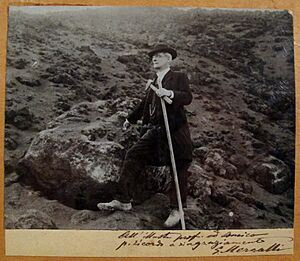Giuseppe Mercalli facts for kids
Quick facts for kids
Giuseppe Mercalli
|
|
|---|---|

Giuseppe Mercalli
|
|
| Born | 21 May 1850 Milan, Kingdom of Lombardy–Venetia
|
| Died | 19 March 1914 (aged 63) |
| Nationality | Italian |
| Known for | Mercalli intensity scale |
| Scientific career | |
| Fields | Volcanology |
Giuseppe Mercalli (born May 21, 1850 – died March 19, 1914) was an Italian scientist. He was also a Catholic priest. He is most famous for creating the Mercalli intensity scale, which is used to measure how strong an earthquake feels and the damage it causes.
About Giuseppe Mercalli
Mercalli was born in Milan, Italy. He became a Roman Catholic priest. Soon after, he started teaching Natural Sciences at a seminary in Milan.
He later became a professor in different Italian cities. He taught at Domodossola and Reggio di Calabria. In the late 1880s, he was a geology professor at the University of Catania. Finally, he worked at Naples University.
Mercalli also became the director of the Vesuvius Observatory. He held this important position until he died.
Giuseppe Mercalli studied volcanoes very closely. He observed eruptions of Stromboli and Vulcano. These are two volcanoes in the Aeolian Islands. His detailed descriptions of these eruptions were very important. They helped create two main types of volcanic eruptions. These are the Strombolian eruption and the Vulcanian eruption. They are part of the Volcanic Explosivity Index.
Mercalli also took a famous photograph of Vesuvius. He captured the volcano right after its eruption in 1906.
In 1914, Mercalli died in his home. His death was unexpected. Some money was found to be missing from his apartment.
Understanding Earthquake Scales
Mercalli created two scales to measure earthquake intensity. These scales were based on an earlier one called the Rossi–Forel scale. His first scale had six levels, but it is not used much today.
His second scale is now known as the Mercalli intensity scale. It has ten levels. This scale gave more detailed descriptions than the Rossi–Forel scale.
The Mercalli intensity scale is still used today in a changed form. It measures the effects of an earthquake. This means it looks at how much damage buildings get. It also measures how people feel the shaking.
This is different from the Richter magnitude scale. The Richter scale measures the energy released by an earthquake. The Mercalli scale is not great for areas where few people live. But it is very useful for comparing damage from different earthquakes. It also helps with earthquake engineering, which is about designing buildings to resist quakes.
The Mercalli scale uses numbers from I to XII.
- Level I means the earthquake was "Not felt, except by a few under favorable conditions."
- Level XII means "Damage total; objects thrown into the air."
Over time, the Mercalli scale was updated. An Italian physicist named Adolfo Cancani added two more levels. These were XI (catastrophe) and XII (enormous catastrophe). Later, a German scientist named August Heinrich Sieberg modified it. This version was called the Mercalli–Cancani–Sieberg (MCS) scale.
It was changed again and published in English in 1931. This version was called the Mercalli–Wood–Neumann (MWN) scale. It was later improved by Charles Francis Richter, who also developed the Richter magnitude scale.
See also
 In Spanish: Giuseppe Mercalli para niños
In Spanish: Giuseppe Mercalli para niños


